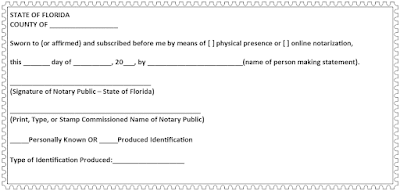Loose Certificates Unleashed: Navigating Notary Challenges with Confidence!
Loose Certificates Unleashed: Navigating Notary Challenges with Confidence!

As a notary public, your responsibilities extend beyond simply affixing your signature and seal to documents. In some situations, a standard notarial certificate on the document may not be feasible or compliant. This blog post will delve into the various types of notary loose certificates and when to utilize them. We'll discuss scenarios where a loose certificate is necessary, such as limited space, non-compliant certificates, split signings, and missing certificates. Additionally, we'll highlight essential loose certificates every notary should keep on-hand, including jurat and acknowledgement certificates, as well as credible witness, signature by mark, or proxy certificates.
1. Types of Notary Loose Certificates
a) Pre-printed Loose Certificate: A separate certificate printed with the required notarial language, ready to be completed and attached to the document.
b) Pre-Ink Stamp: A stamp containing the necessary notarial language, which can be applied to a blank certificate form.
c) Printed onto the Document: In some cases, notarial language may be directly printed on the document itself.
2. When to Use a Loose Certificate
a) Limited Space for Signature and Seal: When the document lacks sufficient space for your signature and seal, attaching a separate loose certificate is appropriate.
b) Non-Compliant Certificate Present: If the existing certificate on the document does not meet the legal requirements, use a separate compliant loose certificate.
c) All Signers Not Present (Split Signing): In scenarios where signers are unable to meet in person, a loose certificate can be used for each signature.
d) No Certificate Present: If the document lacks any notarial certificate, you must attach the appropriate loose certificate.
3. Essential Loose Certificates to Keep On-Hand
a) Jurat Certificate: Used when a signer must swear or affirm the truthfulness of the contents in the presence of a notary.
b) Acknowledgement Certificate: Used when a signer acknowledges their signature on the document as their own, without the need for an oath or affirmation.
c) Credible Witness Certificate: In situations where the signer cannot provide proper identification, a credible witness can vouch for their identity.
d) Signature by Mark or Proxy Certificate: When a signer is unable to physically sign, these certificates allow for alternative methods of signing.
4. Special Circumstances
Always inquire if there are any special circumstances regarding the parties' signing capability to ensure the appropriate use of loose certificates.
Sealing the Deal: Mastering Loose Certificates for Notarial Success!
Understanding the various types of notary loose certificates and their applications is crucial for every notary public. Being prepared with the right loose certificates can help overcome space constraints, non-compliant certificates, split signings, and missing certificates. Keep essential loose certificates on-hand, and remember to inquire about any special signing circumstances to ensure smooth and compliant notarizations. By mastering the art of using loose certificates, you enhance your efficiency and effectiveness as a notary public.


